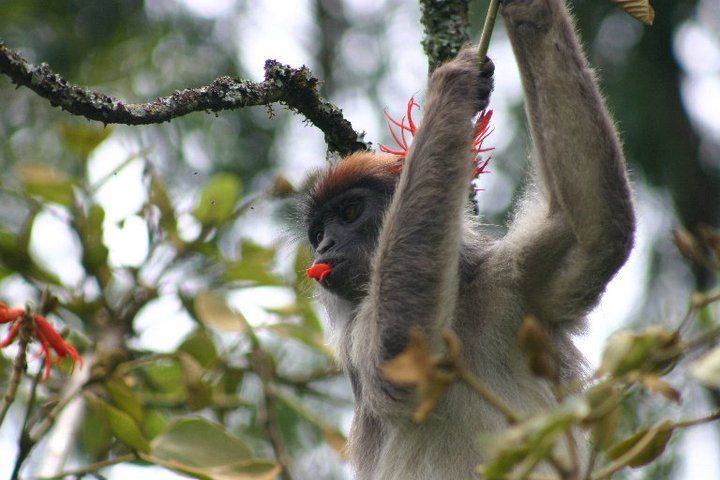WashU Research Team Embarks on Study of Virus Transmission and Human-Wildlife Interaction
Red colobus monkeys can’t seem to get a break. Since 2007, when anthropologist Krista Milich at Washington University in St. Louis established her project at Kibale National Park in Uganda, she has watched their numbers decline. Red colobus are now considered the most threatened group of African monkeys.
According to the IUCN Red List of Threatened Species, every form of red colobus monkey is threatened with extinction. “Kibale has the largest, most viable population of this red colobus species,” said Milich, an assistant professor of biological anthropology in Arts & Sciences. “There are very few living outside of that protected area.”
The monkeys face many pressures, with habitat degradation chief among them. But red colobus are also vulnerable to viruses, including those that spread from animal to animal, and even from humans to other animals.

Milich and her Washington University colleagues Michael Landis, an assistant professor of biology in Arts & Sciences, and David Wang, a professor of microbiology and of pathology and immunology at the School of Medicine, recently won a five-year grant from the National Institutes of Health (NIH) to model viral transmission dynamics among red colobus monkeys and their human neighbors near Kibale National Park. The team received $540,000 for the first year of their five-year project; the total project budget exceeds $2.5 million. Innocent Rwego, a senior lecturer of veterinary medicine at Makerere University in Uganda — a WashU McDonnell International Scholars Academy partner — is a partner on this effort.
The NIH award represents some of the first external funding for a team that came together in 2022 as part of the Incubator for Transdisciplinary Futures, a signature initiative of the Arts & Sciences strategic plan. Their research cluster, “The Human-Wildlife Interface,” is focused on identifying the scenarios likely to promote infectious diseases within and between many different types of animal species, including but not limited to interactions between red colobus monkeys and humans.
The new work will tap into Milich’s existing, long-running research program at Kibale, under which members of her project team follow and observe troops of red colobus monkeys living in areas of the forest with different degrees of human-caused disturbance.
With the funding from NIH, team members will expand their work to include conducting interviews with people living along the boundary of the park with varying exposure risks for zoonotic diseases. The researchers plan to analyze samples from adults and children and from individually identifiable red colobus monkeys to determine if they carry any viruses and learn about how these viruses are related. The samples will be biologically inactivated and analyzed using appropriate biosafety precautions. The scientists also plan to analyze these samples for SARS-CoV-2 to determine if people have transmitted this particular virus to red colobus monkeys.
“What makes this study different is that it will allow us to understand virus populations in the wild in natural settings,” Wang said. “Colobus monkey troops are somewhat independent, but they have varying degrees of interactions with other animals and humans. The ones deep in the forest, we think they’re more isolated. But maybe they interact with a lot more animals, whatever’s out there.”
“We’ll develop a new modeling framework to reconstruct the spread of the viruses using their genomes,” Landis said. “And we can use those tools to pinpoint when and where new infections happened from the location and behavior of the monkeys. A big hope is to learn how individual actions promote or prevent pathogen outbreaks in an ecosystem.”
Many infectious diseases that now threaten humans originated among wildlife, yet we know relatively little about wildlife transmission dynamics and ways to prevent spillover events, Milich said. This project will establish a new epidemiological research framework that could be applied to other ecosystems where humans and wildlife are in close contact.
But on a personal level, she feels very committed to protecting these special primates.
“Colobus monkeys are known to carry pathogens that could be concerning,” Milich said. “They are also endangered species that we should care about in their own right, outside of their potential as a reservoir for disease.”

